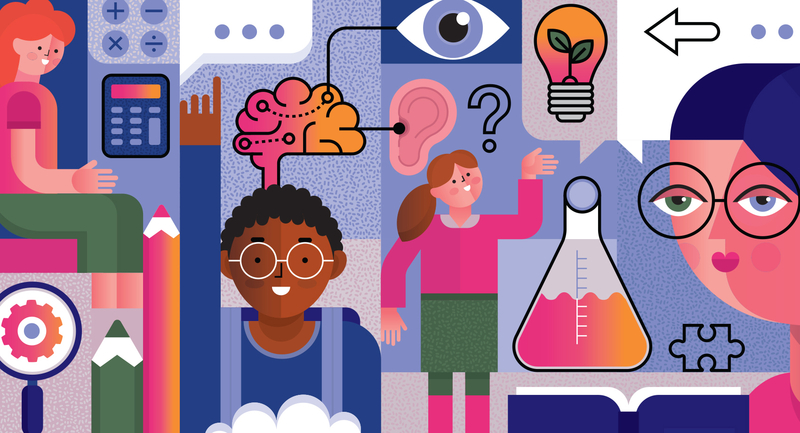I start out every professional development workshop on student collaboration with this image:
Aside from eliciting a good chuckle after an exhausting day, everyone can personally relate— whether you've been a frustrated member of a group project or, as a teacher, watched students struggle in a group activity. In my work supporting teachers across the country in project-based learning, it is rare for me to find a teacher who boasts that they have student collaboration figured out. On the contrary, collaboration is a source of frustration for the vast majority of teachers who cross my path.
I have found that simply providing teachers with a quick-fix list of strategies and best practices for student collaboration only leaves teachers feeling overwhelmed and frustrated. Instead, I encourage instructional leaders to think about supporting teacher development in the realm of collaboration as a crusade: a vigorous campaign in favor of a cause. Crusades are seldom quick, but we invest and engage in the long journey ahead because we believe it is worth it. These are my three main tips for sustaining teachers on their collaboration crusade.
Calibrating Collaboration
As is with all buzz terms in education, there are some pretty muddy waters when it comes to defining productive student collaboration. Although many teachers can tell you what successful small group work does not entail, it is often challenging to find a consistent definition of successful collaboration across a school faculty. When students receive mixed messages about collaboration—what it means, when and how it should happen, how it is assessed, what the expectations are—it is difficult for them to develop this skill. I encourage instructional leaders to take time during the beginning of the school year to calibrate the terms and expectations for student collaboration.
- To ground your crusade in a powerful "why," watch <LINK URL="https://www.ted.com/talks/simon_sinek_how_great_leaders_inspire_action?language=en" LINKTARGET="_blank">Simon Sinek's explanation of "The Golden Circle"</LINK>.
- Ask your staff, "Why is collaboration important for our students? What does successful student collaboration look like, sound like, feel like?" Chart their responses for whole-group discussion.
- Have teachers use video to document student collaboration in their classrooms. In small groups or PLCs, teachers view these videos, using a <LINK URL="http://www.visiblethinkingpz.org/VisibleThinking_html_files/03_ThinkingRoutines/03c_CoreRoutines.html" LINKTARGET="_blank">core routine from visible thinking routines</LINK> to analyze what they see and debrief as a group.
The goal of this early stage of your crusade is simply to develop a common understanding for productive student collaboration so that as a group you can build from this knowledge base in the next two stages.
Assessing Collaboration
To continue in the calibration process, I encourage school leaders to take a step backward and zoom out to see the big picture or plan with the end in mind. Ask your staff, "When our students graduate, what collaboration skills do we want them to have? How will we know if they have developed those skills?"
Charting these responses will help you start to construct a schoolwide rubric for assessing student collaboration. When students are evaluated on the same skills in every class, every year, staff will be able to chart overall student growth on those skills. Collaboration rubrics from any of the following expert organizations can also help you set up your schoolwide rubric:
- <LINK URL="https://newtechnetwork.org/resources/new-tech-network-collaboration-rubrics/" LINKTARGET="_blank">New Tech Network</LINK>
- <LINK URL="https://my.pblworks.org/resources" LINKTARGET="_blank">Buck Institute for Education</LINK>
- <LINK URL="http://www.battelleforkids.org/learning-hub/learning-hub-item/4cs-rubrics" LINKTARGET="_blank">p21</LINK>
Once you have created a draft of your schoolwide rubric, build in staff development time to explore this new tool together. How might teachers differentiate by grade? When might they use specific rows within the rubric over the course of a project, unit, or semester? How will they leverage this tool for formative assessment and build in time for student reflection and teacher feedback?
Scaffolding Collaboration
By this stage of the crusade, teachers are champing at the bit and asking, "Yeah, but how do I teach this?" To avoid overwhelming teachers, I often ask them to focus on one subskill or one row of their rubric at a time. Specific strategies are better suited for individual subskills of collaboration.
For example, if active listening is a subskill on your collaboration rubric, then speaking and listening protocols would be a good fit as a teaching strategy. Depending on where you choose to zoom in to start this stage, here are some best practices and resources to explore:
3 Steps to Supporting the Crusade for Better Student Collaboration - table
Collaboration subskill | Teaching strategy | Resources to explore |
|---|---|---|
| Healthy conversation | Discussion protocols | Engage NYC WeTeachNYC Visible Thinking Routines The Power of Protocols book |
| Active listening | Calibration, listening protocols | Listening Dyads Fishbowl Looks like-sounds like-feels like chart for body language |
| Positive interactions | Role cards (for equal thinking, not just equal doing! | Teachers Pay Teachers CraftED Curriculum |
| Productive group work | Team contracts | Buck Institute for Education New Tech Network Teaching Channel |
Unlike the crusades of history, there really isn't an end point or destination for conquering student collaboration. You can come back to these three stages and reflect on your schoolwide progress at the end of the school year. What improvements in student outcomes (related to collaboration) are you seeing? How is your assessment tool working, and what changes need to be made to it? What best practices are happening inside each classroom, and how are you capturing those?
It's a long journey, but it's a worthy cause, if our students are to become the collaborative problem solvers our future needs.







